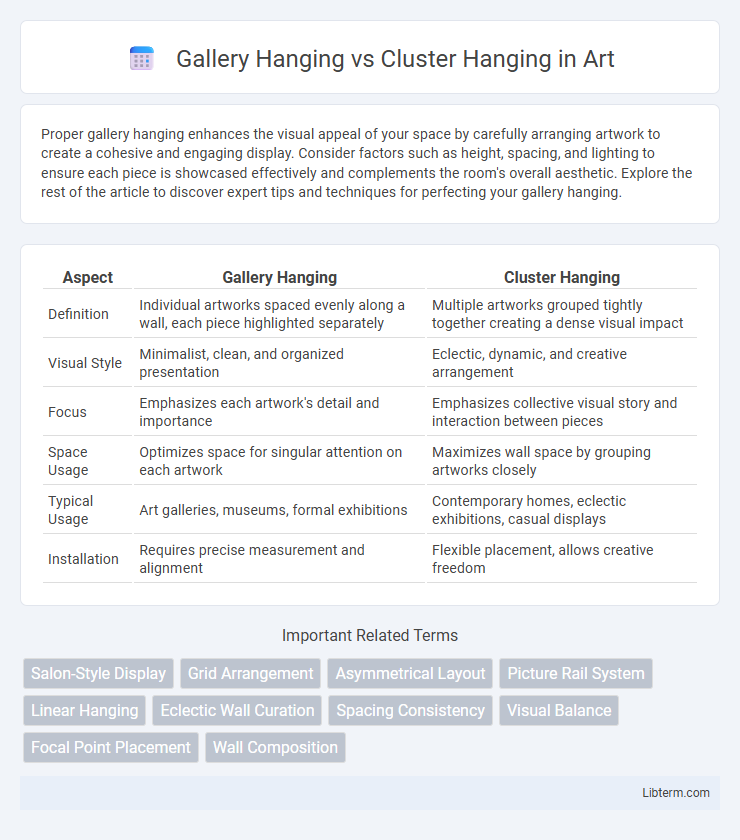Proper gallery hanging enhances the visual appeal of your space by carefully arranging artwork to create a cohesive and engaging display. Consider factors such as height, spacing, and lighting to ensure each piece is showcased effectively and complements the room's overall aesthetic. Explore the rest of the article to discover expert tips and techniques for perfecting your gallery hanging.
Table of Comparison
| Aspect | Gallery Hanging | Cluster Hanging |
|---|---|---|
| Definition | Individual artworks spaced evenly along a wall, each piece highlighted separately | Multiple artworks grouped tightly together creating a dense visual impact |
| Visual Style | Minimalist, clean, and organized presentation | Eclectic, dynamic, and creative arrangement |
| Focus | Emphasizes each artwork's detail and importance | Emphasizes collective visual story and interaction between pieces |
| Space Usage | Optimizes space for singular attention on each artwork | Maximizes wall space by grouping artworks closely |
| Typical Usage | Art galleries, museums, formal exhibitions | Contemporary homes, eclectic exhibitions, casual displays |
| Installation | Requires precise measurement and alignment | Flexible placement, allows creative freedom |
Introduction to Art Display Methods
Gallery hanging emphasizes uniform spacing and alignment of artwork at eye level, creating a cohesive and organized presentation typical in museums and formal exhibitions. Cluster hanging arranges pieces of various sizes and styles in a visually dynamic grouping, enhancing personality and interest in casual or personal spaces. Both methods optimize visual flow and balance, adapting to different environments and viewer engagement strategies.
What is Gallery Hanging?
Gallery hanging is a traditional art display method where artworks are aligned in a single, straight line at eye level, typically around 57 inches from the floor, creating a clean and cohesive visual presentation. This technique emphasizes uniform spacing and consistent height to maintain balance and harmony across the wall, often used in museums and formal exhibitions. Gallery hanging allows individual pieces to stand out while contributing to an overall curated aesthetic.
Defining Cluster Hanging
Cluster hanging is a method of arranging multiple artworks or decorative pieces closely grouped together on a wall to create a cohesive visual statement. This style emphasizes balancing varying sizes and shapes within a defined area to enhance aesthetic impact and thematic unity. Unlike gallery hanging, which spaces artworks evenly for individual contemplation, cluster hanging maximizes wall space by forming a dynamic, interconnected display.
Visual Impact: Gallery vs Cluster
Gallery hanging creates a clean, linear visual impact that highlights each artwork's unique presence through evenly spaced frames usually aligned at eye level, promoting balance and uniformity. Cluster hanging generates a dynamic, eclectic visual effect by grouping various sizes and shapes of artworks closely together, fostering an immersive and informal atmosphere. The choice between gallery and cluster hanging significantly influences room aesthetics, with gallery arrangements emphasizing order and cluster arrangements encouraging creativity and personal expression.
Space Efficiency and Arrangement
Gallery hanging maximizes space efficiency by aligning artworks in a single, consistent row at eye level, creating a clean and organized visual flow ideal for smaller or narrow walls. Cluster hanging optimizes arrangement by grouping multiple pieces of varying sizes closely together, making the most of larger wall areas and allowing for dynamic, personalized displays. Both methods enhance spatial usage but differ in presentation style, with gallery hanging emphasizing uniformity and cluster hanging favoring eclectic composition.
Flexibility and Adaptability
Gallery hanging offers precise alignment and uniform spacing, ideal for curated displays with consistent aesthetics, but it can be less adaptable to varying wall sizes and art dimensions. Cluster hanging allows greater flexibility by grouping artworks of different sizes and styles closely together, creating dynamic visual interest adaptable to irregular walls and evolving collections. Both methods cater to different display needs, with cluster hanging favored for customization and gallery hanging preferred for structured, cohesive presentations.
Choosing Artwork for Each Style
Gallery hanging requires selecting artworks of similar size and framing to create a uniform, linear display that emphasizes cohesion and balance. Cluster hanging allows for more creative freedom by mixing various sizes, shapes, and styles to achieve an eclectic, dynamic visual impact. When choosing artwork, consider the wall space and desired aesthetic; gallery style suits minimalist or formal settings, while cluster arrangements enhance casual or eclectic interiors.
Ideal Spaces for Gallery Hanging
Gallery hanging is ideal for long hallways and narrow walls where artworks can be displayed at eye level in a uniform line, creating a sleek and organized appearance. This method suits minimalist or contemporary spaces, such as museums, art galleries, and modern homes, where emphasis on individual pieces enhances visual impact. Gallery hanging maximizes space efficiency while maintaining a clean, structured aesthetic.
Best Settings for Cluster Hanging
Cluster hanging is ideal for creating a dynamic focus area by grouping artwork of varying sizes and styles closely together, providing an eclectic and personalized display. Optimal settings include balancing the overall visual weight, spacing artworks 2-4 inches apart, and aligning the cluster's center at eye level, typically around 57-60 inches from the floor to enhance viewer engagement. Using a variety of frame styles and consistent color themes in cluster hanging can unify the display, making it more visually appealing and cohesive.
Tips for Perfect Art Wall Installation
Gallery hanging offers a structured and symmetric arrangement, where art pieces align precisely at eye level for a cohesive visual flow; measuring the wall height and centering the midpoint of the layout at 57-60 inches from the floor ensures balance. Cluster hanging encourages creative freedom by grouping various frame sizes and styles, requiring careful spacing of 2-5 inches between pieces to maintain harmony without overcrowding. Using painter's tape to outline the arrangement beforehand and adjusting based on natural light and furniture placement enhances the overall aesthetic impact of any art wall installation.
Gallery Hanging Infographic

 libterm.com
libterm.com